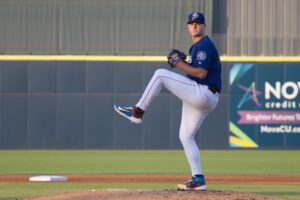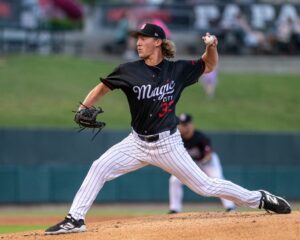In-person Scouting Notes and Video on Birmingham Barons Position Players
I took in three games in Birmingham this past weekend, where I was able to interview some players, take some video and chat with a few scouts about players on the Barons. The analysis of the team’s pitchers was published recently, and this one will be a scouting-centric focus on some key White Sox hitting prospects in AA. Along with the embedded videos, the reports below should give you a detailed picture of prospects like Tim Anderson, Jacob May, Nick Delmonico, Danny Hayes and more…
(SS) Tim Anderson:
The soft-spoken Tuscaloosa native showed flashes of what makes him, in the eyes of many, the top prospect in the White Sox organization and one of the most tantalizing talents in all of the minor leagues. Before this trip to Birmingham, I was curious to see the plate approach, discipline, and spin recognition in context with his sterling .316 batting average. I originally thought that, at some point, the noise about his plate discipline was far too loud – all this guy does is hit, right? Anderson’s going to carry a high BABIP due to his speed, yes, but more importantly the charge he puts into balls that he squares up. With lightning quick hands, strong wrists, and well above average bat speed, it’s hard to throw a fastball by Anderson, especially if it is middle away – Anderson’s sweet spot, according to the man himself.
But what gave me pause in the course of the three games I saw of Anderson was that, well, there was no reason to throw him a fastball. And as he eventually hits his way out of AA, there are going to be fewer and fewer pitchers that have to throw fastballs even when they’re behind in the count. Even then, a slight loop in Anderson’s swing gives him trouble with fastballs in. In an interview, Anderson admitted that he had been quite frustrated with how the series had gone, with a lot of swing and miss in each plate appearance. It should be noted that at least two of the three starting pitchers he faced (Taylor Guerrieri and Jacob Faria) will almost assuredly be 40-man protected following this season and project as #4 starters or better. But the guy that gave Anderson the most trouble was Chris Kirsch – a lefty whose FB sat 88-91 with solid average offspeed offerings, routinely getting Anderson out in front with change-ups low and in the zone. Despite this, clearly, Anderson is gifted with elite hand-eye coordination and I saw that first-hand. He’s going to hit mistake breaking balls and offspeed stuff that is left up, but he presently struggles with resisting “slow and low” pitches.

Anderson has a bat wiggle that resembles that of long-time Cincinnati Reds 2B Brandon Phillips and an abbreviated toe-tap for timing purposes. The crux of Anderson’s success could actually depend on what position the White Sox choose for him going forward (they, along with Anderson, have been adamant that SS is his future position). One scout suggested and felt confident that a move to CF – not 2B – would prove ultimately beneficial to Anderson’s hit tool, such that he would be able to “relax” defensively and direct his efforts towards each plate appearance. The scout noted that Anderson has the speed and arm for CF. Unfortunately, due to a shoulder injury he sustained on a triple a few series ago, I did not see Anderson at SS – only during fielding drills did I see him and it wasn’t too intensive to discern much, if anything. Should Anderson continue to hit into AAA and improve his pitch selection such that the hit tool is M.L. ready and the defense and instincts lag behind at SS, a move to CF would expeditie his arrival, allowing his speed and overall game-changing ability to play.
In this five-game-series, Anderson was picked off a few times on the basepaths. I was there on one occasion where he took an ambitious secondary lead and was back-picked by Justin O’Connor’s 80-grade arm. That is something that should be in the scouting report and internalized. What it came down to for a scout I talked to was Anderson’s “baseball instincts” (e.g. not running into outs on the basepaths, situational awareness both at SS and at the plate, etc). Whether that’s something that can improve as Anderson accrues more reps remains to be seen. Anderson is still raw and deserves immense credit for the results he’s produced this season. Furthermore, (knock-on-wood) making it through an entire season relatively healthy at SS, while stealing more than 50 bags speaks to his athleticism and conditioning. With above average raw power and the bat speed and hand-eye coordination to complement that, an uptick in Anderson’s power (.114 ISO this season) should also develop down the line as that’s usually something that occurs later in the development process. From a tools and projection standpoint, Anderson’s current form is a unique one among his peers – and to be making this much contact at AA for someone who’s relatively new to baseball is nothing short of remarkable, especially considering that he turned 22 just two months ago.
1B Danny Hayes:
Seeing Hayes in contrast to Anderson was very interesting. Hayes, who has bumped up his BB% and decreased his K% since his 2014 season at Kannapolis, possesses plus raw power – especially pull side – that has yet to manifest itself this season (.106 ISO, seven homers, .358 SLG). Hayes easily strung together the most impressive plate appearances in the three games I saw him, which included three homers (one a grand slam in front of a sold out Regions Field). Hayes was not simply working himself into favorable counts by not swinging – he was truly waiting for his pitch, selectively aggressive, even swinging at the first pitch if it looked like something he should drive. He’s not moving to the OF – this is a true 1B prospect that doesn’t run, who is average to above average defensively. Hayes is 24 year old, and he should be succeeding at this level, but in my viewing, I saw a legitimate prospect that could crack the big leagues. The age topic should have a caveat here as well, as Hayes skipped Advanced A to to go AA this year, only his second season as a pro. The only way to break out of the AAAA 1B mold that we’ve witnessed with Andy Wilkins is by, well, mashing and continuing to practice an advanced approach. The three game window that I saw Hayes could very well be the “turning of a corner” for the broad shouldered, 6’4” Oregon State product.

CF Jacob May:
As I wrote in the mid-season top 30 update, up-the-middle players that project as starters (albeit second-division) don’t come around that often. May is a true CF with the arm, speed (I clocked him at 4-flat home to first), and instincts for the position. Like with a few other OF prospects in the organization (see: Adam Engel, Courtney Hawkins, Trayce Thompson, and others), his ceiling truly depends on his hit tool – which, in my viewing, looked fringe average, at best. The bat speed was average and there was little natural lift to the swing. The scout I spoke with put 20 game power on May. It may be a question of swing mechanics or approach, but it has nothing to do with his strength: May is chiseled and has an impressive physique. I could have caught May in a rut, especially with him coming off the concussion (which the Barons showed a few times on their video board as a sort of comeback story to hype). Concussions are tricky and you’d like to see May remain out on the field as he has and not change his game – stretching singles into triples (which he did on a bunt and a throwing error) and playing a sound to plus defensive game out in CF. I think May is a very valuable piece given his floor and, should the hit tool develop, he could be a regular.
3B Nick Delmonico:
I did not get to see Delmonico in-game as he was out due to a staph infection. He has resumed action recently, slotted into the third spot in the order – suggestive of what the organization thinks of him as I received a tid-bit from a well-connected season ticket holder that Buddy Bell sets the top three of the lineup. That’s likely just a measure to get him more plate appearances but is still an interesting insight should it prove accurate. Either way, Delmonico is a third baseman – I saw him taking a couple grounders in field instructs and he looked athletic and fluid. Delmonico is one of, if not the, most physically advanced guys on the team. He looks like a big leaguer and is a big personality with an infectious sense of humor. His BP session was equally impressive and he generated a lot of backspin on the ball with good lift in the swing. He’s hitting at around league average in his first go-around in AA following his disappearance from the Brewers this past off-season. Given that turmoil, the results in 2015 are encouraging for a system with few legitimate position player prospects. He’s an intriguing guy to follow into 2016. A lot of his ceiling depends on if he can stick at 3B, and he is confident that he will remain there.
C Adrian Nieto:
Nieto displayed a textbook case of a loop in his swing. He was consistently beat by low 90’s heat anywhere in, or out, of the zone. It looked as if he was pressing and anxious to make contact, or – as a scout put it – “add to his five home runs.” Defensively, he worked pitchers pretty well and called a good game for Blackmar, clearly. He’s really struggled this season at the dish, losing playing time to guys like Jeremy Dowdy and having Rob Brantly outperform – and, ultimately, surpass him within the organization. The 16.6 BB% is interesting, but the lack of contact and K% (near 25%) is pretty discouraging given the lack of power (.317 SLG). There might be something to the notion that the big-league exposure (as a Rule V pick in 2014) hurt him developmentally going forward.
2B Joey DeMichele:
A physically maxed out 2B standing 5’9”/5’10”, DeMichele showed some surprising pull-side raw power in BP and even cranked one out in-game that went into the second section in RF. He is capable defensively and runs pretty well. He’s a competent, good player, but is likely organizational depth as a 24 y/o with an 88 wRC+ and no major league tools that I saw.
**Courtney Hawkins is still on the disabled list, so I wasn’t able to get a look at him.
With Anderson and May headlining, Birmingham boasts two of the higher (highest, with regard to Anderson) ceiling position players in the organization. There is, however, some depth with Delmonico and especially Hayes, who really impressed.
Want to know right away when we publish a new article? Type your email address in the box and click the “create subscription” button. Our list is completely spam free, and you can opt out at any time.






